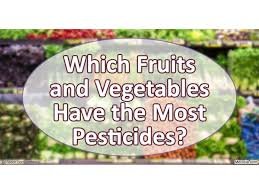Strawberries Top Dirty Dozen List for Pesticide Residues — Again
 Despite being linked to depression, endometriosis and a host of other health complications, the overuse of pesticides in American agriculture continues.
Despite being linked to depression, endometriosis and a host of other health complications, the overuse of pesticides in American agriculture continues.
And findings of dangerous of pesticide residues aren’t limited to the fruits and vegetables we count on for nourishment. The chemical buildup from pesticides has been found in everything from wine, to tea and even honey, from bees coming into contact with pesticide-laden crops.
And there seems to be no end in sight.
For the third year in a row, strawberries top the Environmental Working Group’s (EWG) Dirty Dozen list of fruits and vegetable with the highest levels of pesticide residues. The annual list serves as a reminder of why it's important to buy organic produce, at least buy the organic variety of the worst offenders, such as strawberries.
The Dirty Dozen
For the past 15 years, the EWG has issued a Shoppers" Guide to pesticides in Produce, which ranks pesticide contamination in the most popular fruits and vegetables. Approximately one-third of the strawberry samples tested contained at least 10 pesticides, while one sample contained 22 pesticides. Spinach was ranked in second place, with 97 percent of samples testing positive for pesticides. Following spinach, the other dirty dozen included nectarines, apples, grapes, peaches, cherries, pears, tomatoes, celery, potatoes and sweet bell peppers. In addition to the 12, the EWG included a 13th suspect of hot peppers, which contained insecticides that are highly toxic to the nervous system.
The EWG report was based on a study by the U.S. Department of Agriculture that conducted nearly 39,000 tests on 47 fruits and vegetables. Almost 70 percent of the nonorganic or conventional produce tested had pesticide residues.

The Clean Fifteen
On the positive side, the EWG issued a Clean fiftten list featuring fruits and vegetables with the least pesticides. Avocadoes earned the top spot, followed by sweet corn, with less than 1 percent of samples of each showing pesticide residues. Next in line on the list were pineapples, cabbages, onions, frozen sweet peas, papayas, asparagus, mangos, eggplants, honeydew melons, kiwis, cantaloupes, cauliflower and broccoli.
GMO Foods
Although most processed foods contain genetically modified organisms (GMOs), such as corn oil and corn syrup, most supermarket produce is non-GMO. However, the USDA reports that a small percentage of sweet corn, zucchini and yellow squash are GMO. Most Hawaiian pineapples are GMO as well. Because federal law doesn’t require labeling of GMO produce, the EWG advises consumers to purchase organically grown varieties of these foods. To avoid GMO ingredients in processed food, look for products with a Non-GMO Project Verified or Certified Organic labels.

Risks From Pesticides
Children are more vulnerable to the adverse effects of pesticides, the EWG report said: it cited a 2012 American Academy of Pediatricians study that indicated the effects can include behavioral and neurodevelopmental problems, asthma, birth defects and cancer. The report also quoted JAMA Internal Medicine and Harvard University EARTH studies that found eating pesticide-laden forms of produce can impair the reproductive health of both men and women.
Tips for Reducing Pesticide Intake
All fruits and vegetables are extremely nutritious, so people should continue to eat them in plentiful quantities. The EWG advocates buying the organic variety of produce on the Dirty Dozen list. Those who are unable to afford organic produce can reduce their pesticide exposure by choosing the conventionally grown varieties with lower pesticide residues.Wash all produce, even the organic kind. Washing fruits and vegetables for a minimum of 30 seconds under tap water can reduce pesticides, according to the Connecticut Agricultural Experiment Station. Scientists at the agency found commercial produce washes aren’t an advantage, as they didn’t remove more pesticides than plain tap water.
The National Pesticide Information Center provides further tips on reducing pesticide exposure. These include discarding the outer layers of leafy vegetables like lettuce and cabbage, along with peeling conventionally grown produce that has high pesticide residues. They also recommend trimming fat off meat, fish and poultry before cooking to decrease the ingestion of pesticides that may accumulate there.
By Mary West
http://www.liveinthenow.com/article/strawberries-top-dirty-dozen-list-for-pesticide-residues-again
